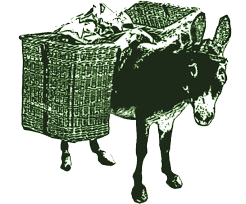Chalford Hill is a fairly recent name for the western end of the hill above Chalford Valley, its old name being Chalford Lynch – indicating a terrace following the contours of a hill. Cottages were built (illegally) on the edges of Bisley Common as squatter settlements in the late 17th and early 18th centuries to house weavers and other cloth workers for the growing industries in the valley bottom.
Between Chalford and Chalford Hill are areas where the racks for stretching and drying cloth were erected, generally on land which was open and unsuitable for any other use. One of these, Rack Hill, retained the name even after the enclosures of 1869. Other racks stood on the common to the north of Chalford valley at St Mary’s near Sunnyside, on the site of the present vicarage and in the area behind the Wesleyan Ebenezer chapel.
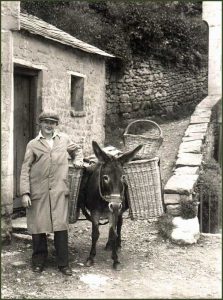
As the wool trade changed so did the prosperity of the area. By the mid-19th century, the cloth industry had largely moved north, and the local villagers fell on very hard times. Eventually, new uses were found for the mills in the valley and employment was thereby maintained. Interestingly, after WWll a survey found that over twenty-five percent of cottages were deemed unsuitable for habitation.
Chalford Hill and Chalford have an extraordinary number of paths (28 km within the parish as a whole), winding up the steep hillsides. They allowed workers to quickly reach the mills in the valley – a majority of the paths leading straight down. They also enabled goods to be transported up and down the hill by donkey – originally this would have been wool and woven cloth, but later bread, coal and produce were carried this way. Some even called the area ‘Neddyshire’. Until the 1930s the donkey could be seen carrying panniers up the steep paths. A few years ago, an enterprising residents bought a donkey that, once again, carried goods from Chalford Stores around the village.
Amongst the lovely stone dwellings there are many larger, grand houses which started as humble cottages to which wealthy mill owners added extra rooms and imposing fronts. Burcombe House is one example, having a late Regency front, whilst the rear sections are mid-18th century.
The Corderries at the top of Dark Lane is another.
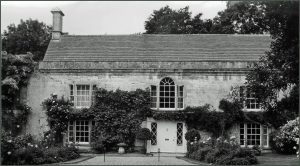 The Corderoys were a Hugenot family and amongst the very first to live at the house that bore their name, Corderoy House, from 1680 onwards. Originally a cottage, it was altered and enlarged in two rebuilding phases in the middle of the 18th century and early 19th century. The name The Corderries came later. It has been the residence for many interesting people, a history which can only be touched on here. It was in this house in 1747 that Edward Corderoy agreed to sell two cottages on Coppice Hill that became Chalford’s first Baptist Chapel.
The Corderoys were a Hugenot family and amongst the very first to live at the house that bore their name, Corderoy House, from 1680 onwards. Originally a cottage, it was altered and enlarged in two rebuilding phases in the middle of the 18th century and early 19th century. The name The Corderries came later. It has been the residence for many interesting people, a history which can only be touched on here. It was in this house in 1747 that Edward Corderoy agreed to sell two cottages on Coppice Hill that became Chalford’s first Baptist Chapel.
Jacob Bath, who bought the house in 1825, had had an exciting career as a Surgeon in the 66th Regiment of Foot. He lived with his sister Rebecca and converted an outbuilding that had been used for storing and drying wool (now called the Weaving Barn) into a dispensary, and for eleven years worked as a village doctor, remembered for giving medicines free to those who were unable to pay. He was the first in a series of medical men who lived at The Corderries finishing with Dr M.G.Dill who bought it for £2,100 in 1924. Five years later the property was bought by Mr E.F.W.Hastings; later in 1935 a nationally important bacteriologist, Dr G.T.Western, was living there until his sudden death in 1952.
The Corderries was often used for the enjoyment of the village. Fetes were held in the adjoining field. The Cheltenham Chronicle in August 1921 noted: The local branch of the British Legion held a very successful fete with over 1,000 people attending, finishing with dancing on the lawn of The Corderries in the evening to the strains of the Chalford Brass Band.
Band and Orchestra
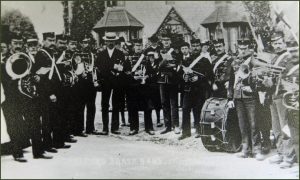
In the nineteenth century most people had to provide their own entertainment and many villages, workplaces and organisations had their own bands and small orchestras. One of the earliest mentions of a Chalford Band is in the Gloucestershire Chronicle of 13 June 1846: Painswick Horsepool Benefit Society … The members headed by the far-famed Chalford Band, proceeded to Pitchcombe Church.
However, the present Chalford Band has a continuous history only from 1885, when they played at a village concert on 12 February, with Thomas Davis as their first bandmaster. They have been delighting audiences and winning prizes ever since. From the earliest days they practised hard and played in numerous fetes, parades and concerts. Processions and parades for both Liberal and Conservatives have been headed by the Chalford Brass Band on many occasions.
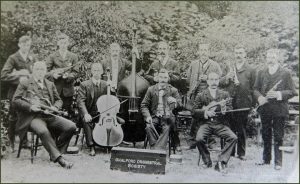
Musicians belonged to more than one musical group. Thomas Davis, for example, was known to play his cornet as a member of the The Chalford Orchestral Society.
In 1935, when the Ham Mills Band at Thrupp was disbanded, Chalford Brass Band bought their uniforms and instruments. These were silver plated, so the band changed its name to Chalford Silver Band. Since 1980, however, the band has been called simply the Chalford Band.
Pubs
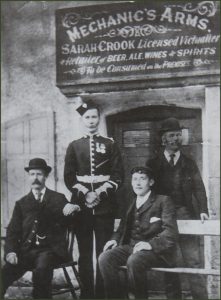
The Mechanics Arms (now the Old Neighbourhood Inn) opened in 1856, many years after the other main public houses – the Duke of York (1831) and The Wheatsheaf (1842).
Until the turn of the century, the landlord at the Mechanics Arms was a Crook – first Laban, then his son Oliver and afterwards Sarah, Oliver’s widow. The Stroud and District Motor Club used the Mechanics Arms as their base and The Mechanics Trial was started in the late 1970s. The landlord and landlady at the time, Jim and Polly, presented The Mechanics Trophy to run an event in the pub’s name. It first ran in 1979 and was held at Badgers Wood, Cowcombe, Chalford.
The Wheatsheaf in Silver Street closed in the 1950s and was demolished so that the small Wheatsheaf estate could be built. The Fleece Inn and the Duke of York have both become private residences.
Places of Worship
Around 1747 the Baptist chapel was first built on Coppice Hill in the buildings just below the current Tabernacle, which was completed in 1847 and is still active. The early 19th century was a busy time for the independent churches in Chalford Hill. In 1819 the France Congregation Church was built as a replacement for the older one in France Lynch and was actively supported until the 1970s by which time numbers attending had dwindled. It was closed and the chapel was turned into apartments in 1985, while the burial ground became the responsibility of the Parish Council. In 1823 the Primitive Methodist Chapel (now the Methodist Church) was built in Midway. It is still used for worship and now has a modern extension to the front and left of the old building.
Education
Chalford Hill British School (now Chalford Hill Primary School) opened in 1874, following the Elementary Education Act of 1870 that paved the way for universal schooling. Prior to this there had been a school near the present site from about 1840, supported by the Baptist and Congregational churches. It is thought that the new building was financed by William Dangerfield. Like many other schools built in this period, the style emulated that used for churches and chapels – somewhat imposing and with high ceilings. The wide windows were designed to let in plenty of light – vital at a time when no artificial lighting was available. Initially run by a School Board, in 1902 the school came under the control of Gloucestershire County Council and in 1932 it absorbed the pupils from France Lynch School when that closed.
By 1914, in addition to the ‘School Room’ (now used as the hall), there were six classrooms. The school room was used by the infants – subdivided into the ‘Babies Class’ and a room for the older infants, up to the age of 7. The other block was used by the juniors, where pupils would have sat in rows at narrow wooden desks. The toilets were in an outdoor block, demolished in 2002. This block also provided a divider in the playground so that girls and boys could play separately. The land opposite the main school buildings (currently housing temporary classrooms) was leased to the school by the France Congregational Church.
Amenities
Until recently, Chalford Hill was well served by shops. Most were general stores and were situated in Midway, Silver Street, Commercial Street and a couple near the Duke of York public house, with a small shop and attached Post Office at the top end of Pudney Pie Lane. All have now closed.
